Gomoku Gohan (Japanese Mixed Rice) is rice cooked in seasoned dashi stock with 5 vegetables. The rice is cooked in the seasoned dashi stock that the vegetables are pre-cooked in, so the cooked rice gets a good flavour from the vegetables. You can almost eat the rice by itself without any other dishes!
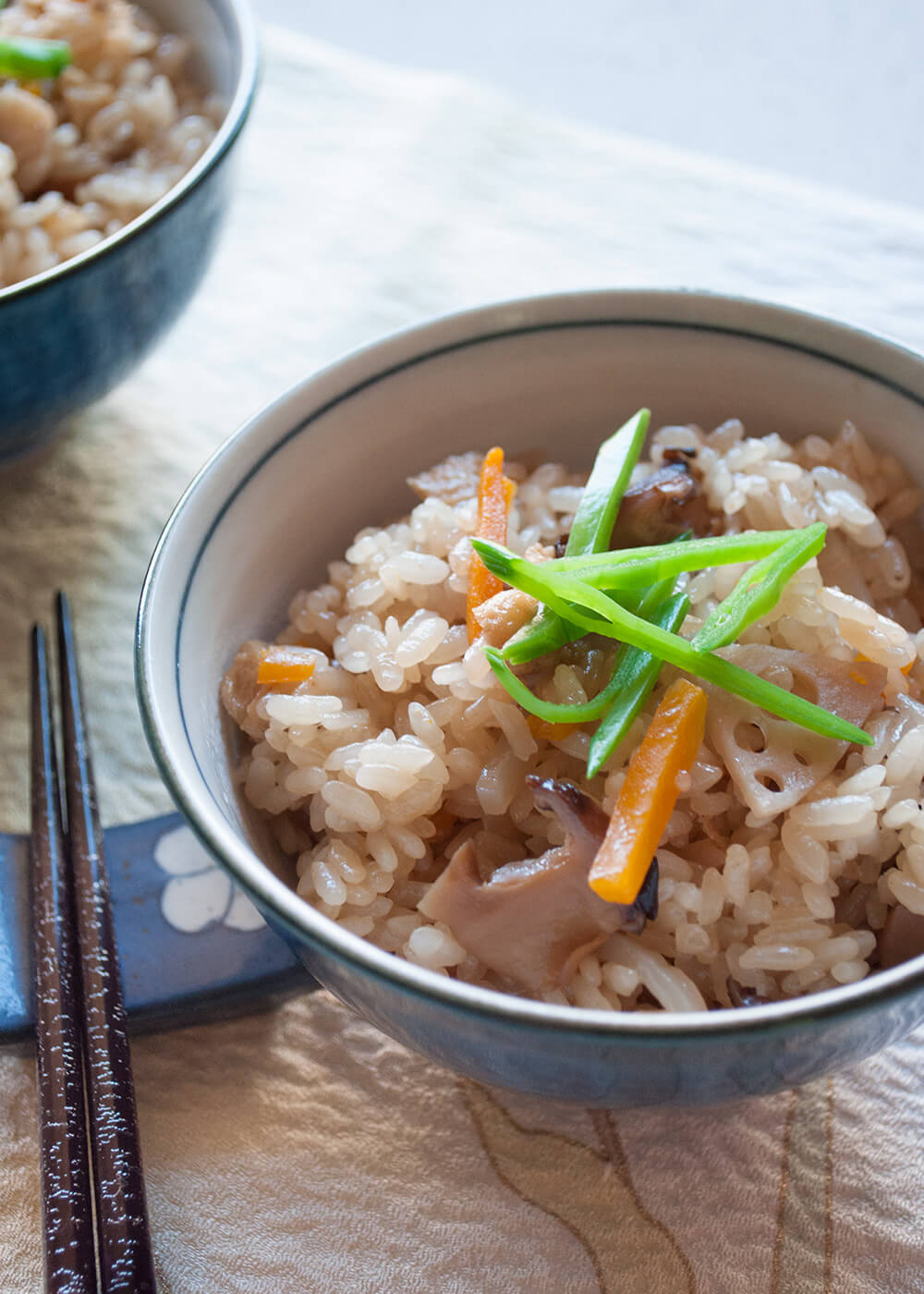
Gomoku gohan (五目ご飯) means five items rice. ‘Go’ (五) is five (number ‘5’) and ‘Gomoku’ (五目) is 5 items. So, it means 5 ingredients in this context. Without including the rice, topping and seasoning, that is. Because various vegetables are mixed in the rice, I translated it to ‘Japanese mixed rice’.
It is also called takikomi gohan (炊き込みご飯). Takikomi gohan is a generic name for rice cooked with vegetables and/or meat. My recipe, Shimeji Gohan (Rice with Shimeji Mushrooms) is also a takikomi gohan. In the Kansai region (the western region of Japan that includes Kyoto and Osaka), it is also called kayaku gohan (かやくご飯).
The ingredients in mixed rice can vary and sometimes they include meat or seafood. But in this recipe, I used only vegetables. If you use dashi stock made only from kelp instead of using katsuobushi (bonito flakes), you can make mixed rice 100% vegetarian.
I used lotus roots, carrot, dried shiitake mushrooms, konnyaku (yum cake – see my post Tonjiru (Pork and Vegetable Miso Soup) for more details of konnyaku) and aburaage (deep fried thinly sliced tofu) but you can use other ingredients such as daikon (white radish), burdock, bamboo shoot, and cubed chicken.
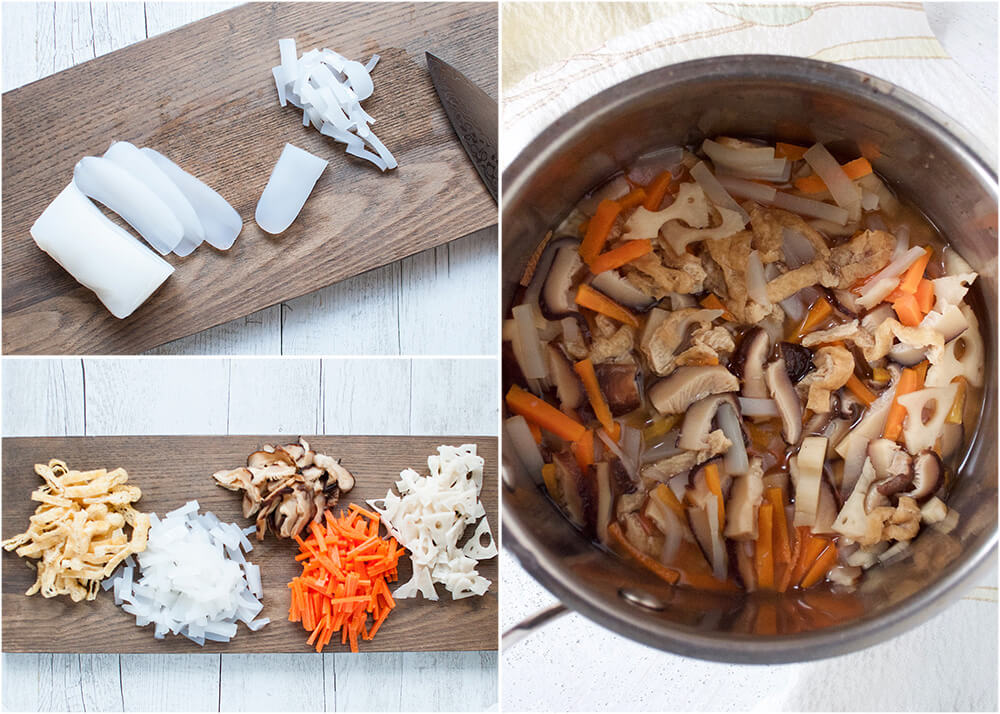
There are two different ways of making mixed rice. My method is to cook the vegetables first in seasoned dashi stock, then use this stock to cook the rice with the pre-cooked vegetables on top. The other method is to place chopped uncooked vegetables on the rice and cook in seasoned dashi stock.
Shimeji Gohan (Rice with Shimeji Mushrooms) is a good example of takikomi gohan cooked using the latter method. In the case of gomoku gohan, I think that the pre-cooking method gives more flavour to the vegetables.
Because the vegetables are cooked in lightly flavoured dashi stock and the rice is cooked in this with vegetables on top, it gives the rice a great flavour of vegetables as well when cooked. I can eat just gomoku gohan without main dishes to go with it.
It is important to cut the vegetables into similar sizes so that the ingredients are blended nicely with the rice when mixed.
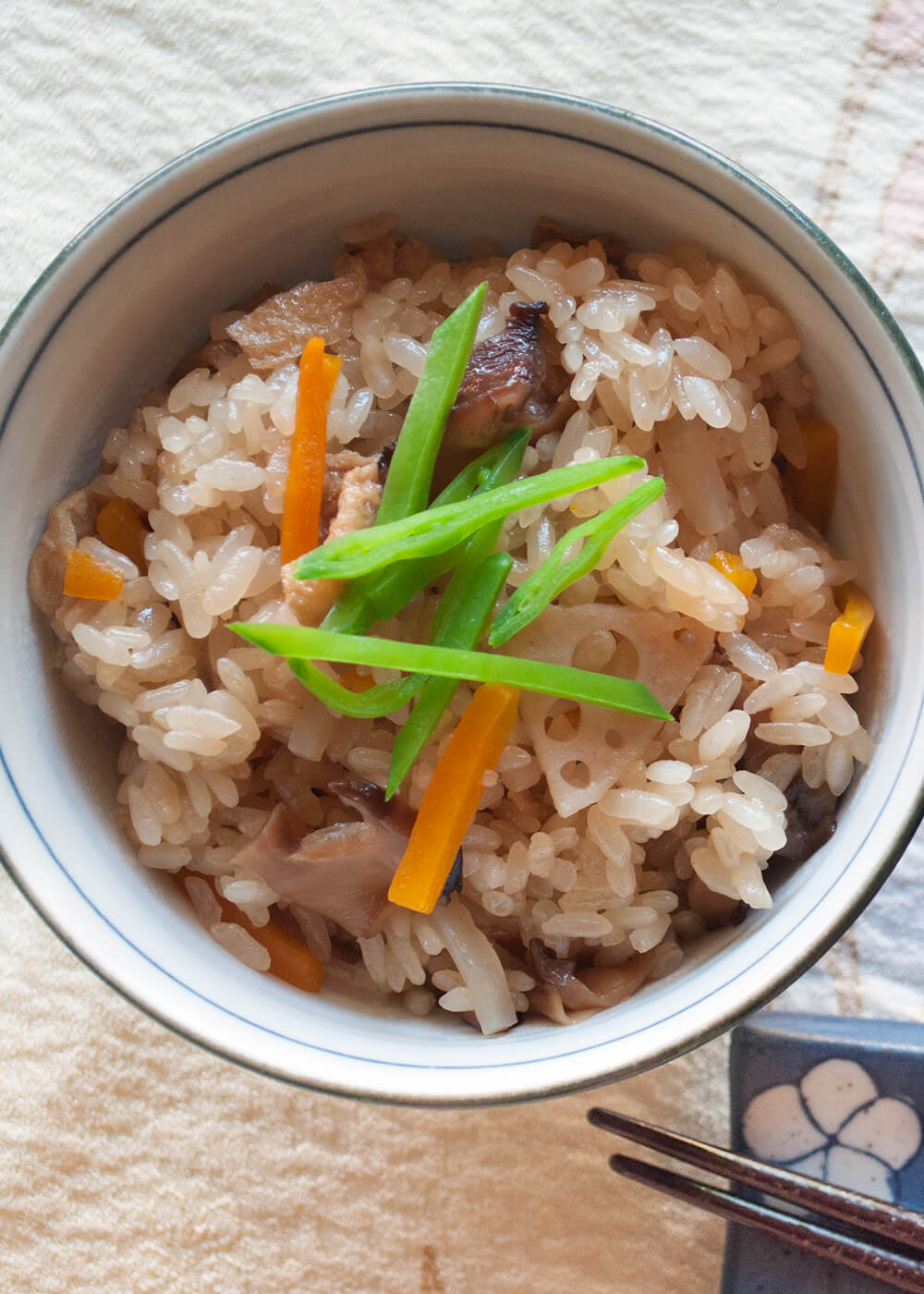
Working Out Amount of Water to Cook Mixed Rice
I used a mixture of sticky rice and short grain rice in this recipe (3:1 respectively) but you can make it with just short grain rice or you can decrease the amount of sticky rice. You could also make it with just sticky rice grain but I find that rice becomes too soft for my liking. You may want to experiment with different proportions of rice and sticky rice.
Depending on the ratio of short grain rice to sticky rice, you will need to adjust the quantity of liquid to cook the rice. This is because sticky rice does not require as much water to cook as short grain rice, i.e. while 100ml (3.4oz) of short grain rice needs about 120ml (4.1oz) of water to cook, 100ml (3.4oz) of sticky rice only needs 80ml (2.7oz) of water.
So, using the formula below, you can calculate the total amount of water/liquid required to cook any ratio of short grain rice and sticky rice. Please note that it is volume (ml, oz, cc or cups), not weight.
Total water/liquid required = volume of short grain rice x 1.2 + volume of sticky rice x 0.8
You can buy sticky rice at Japanese/Asian grocery stores. Japanese sticky rice is called ‘mochi-gome’.
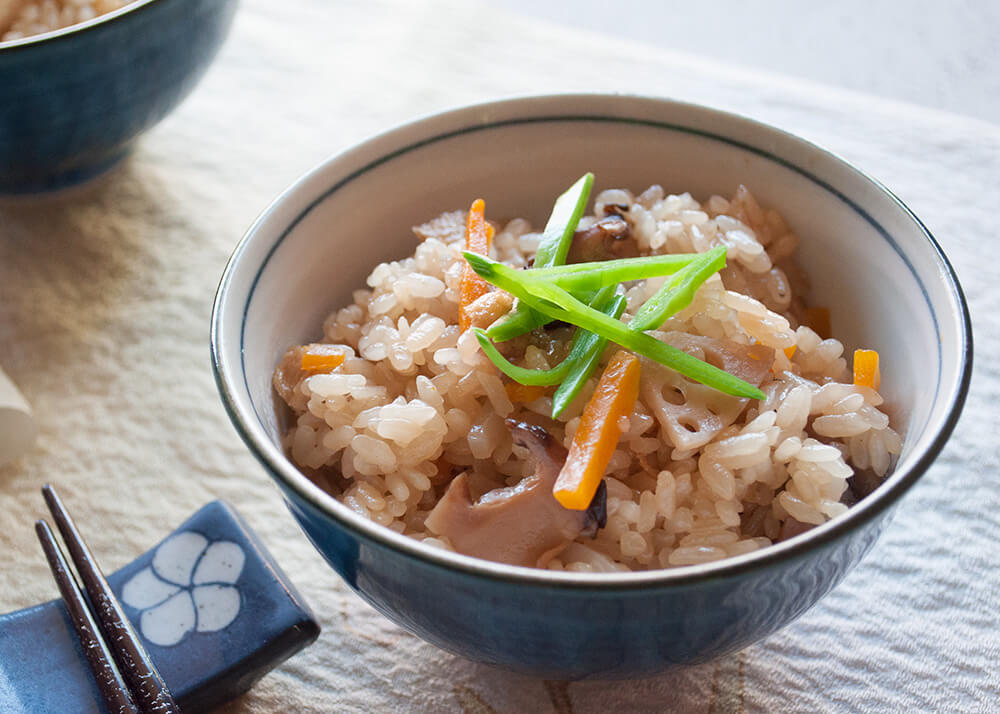
To cook mixed rice my way, pre-cooked vegetables are placed on top of washed rice. Then add the required quantity of seasoned dashi stock used to cook vegetables and some water. Cook it just like the normal rice – please refer to How to Cook Rice the Japanese Way for the cooking method.
I usually make mixed rice when I have a small amount of various vegetables left over. I also serve mixed rice instead of plain cooked rice when I feel that the main dish and sides lack variety.
Yumiko![]()
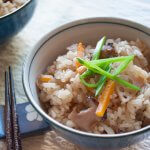
- 360 ml (12.2oz) rice I used 1/4 short grain rice + ¾ sticky rice (note 1)
- 50 g (1.8oz) lotus roots (note 2)
- 50 g (1.8oz) carrot
- 1 aburaage
- 2-3 dried shiitake mushrooms soaked in water and rehydrated (note 3)
- ½ block of konnyaku (note 4)
- 200 ml (6.8oz) dashi stock (note 5)
- 100 ml (3.4oz) shiitake-dashi from dried shiitake in water (note 3)
- 2 tbsp sake
- 1 tbsp soy sauce
- ⅔ tsp salt
- 1 tsp sugar
- 5-6 snow peas blanched and sliced thinly diagonally (note 6)
-
Wash rice until water runs clear. Soak the rice in water and leave it for 30 minutes.
-
Slice lotus roots 2mm (1/16") thick, then cut into 6-8 pieces (I cut them like pizza). Cut carrot into 3cm (1¼") lengths, then into 2mm (1/16") thick sticks.
-
Cut aburaage in half lengthwise. Place one strip onto the other and cut them into 4mm (3/16") wide strips perpendicular to the first cut. Slice konnyaku into 3mm (⅛") thick slices, then cut them into 3mm (⅛") thick short sticks.
-
Squeeze shiitake to get water out (preserve shiitake liquid). Remove and discard the stems, then slice shiitake thinly. If the shiitake is large, cut it in half, then slice so that each slice will not be too long.
-
Add the Seasoned Dashi Stock ingredients into a pan over medium high heat. When the stock starts boiling, add lotus roots, carrots, aburaage, konnyaku and shiitake mushrooms. Cook for 2 minutes and turn the heat off.
-
Using a sieve, drain the liquid into a bowl and leave the vegetables and the liquid to cool down.
-
To cook mixture of sticky rice and short grain rice per the ingredients list, you will need 325ml (11.8oz) of liquid. Using a measuring cup, add all of the liquid collected in step 6 and adjust with water (if not enough) to make up to 325ml (11.8oz).
-
Drain the water from the rice as much as possible using a sieve and place the rice in a heavy bottom pot, spread the cooked vegetables over the rice (do not mix), then add the 325ml (11.8oz) liquid.
-
Place the lid on and cook as per the steps 5 & 6 of the instruction in How to Cook Rice the Japanese Way. (note 7)
-
Serve in a rice bowl with snow peas as garnish if using.
1. The ratio of sticky rice and normal rice can vary and it is really to your liking. But if you increase or decrease the amount of sticky rice, the amount of the liquid required to cook the rice will have to be adjusted since sticky rice needs much less water to cook in.
You can work out the required amount of water using the formula below.
Volume of sticky rice x 0.8 + volume of short grain rice x 1.2 = amount of water
2. Lotus roots are seasonal vegetables and fresh lotus roots may not be available when you need it. But don’t worry, you can use frozen lotus roots, which I often do. Asian grocery stores sell frozen sliced lotus roots in a pack.
In Sydney, I can get thinly sliced lotus roots as well as thick slices. In the case of thick slices, I normally cut them in half (semi circle), then slice into 3 thin slices before chopping them into pieces.
3. Do not use hot water to speed up the process of rehydration. Dried shiitake produces most umami at 5 centigrade. So, if you can plan ahead, rehydrate shiitake in the fridge overnight.
If in a hurry, soak shiitake in water for 1 hour. Slice them (the inside might still be dry) and put them back in the same water and leave for 30 minutes. The liquid from the dried shiitake is called shiitake-dashi (vegetarian dashi stock) which is used to cook the vegetables in this recipe.
4. Konnyaku is a yum cake, made from konnyaku potato. Please see my post Tonjiru (Pork and Vegetable Miso Soup) for more details of konnyaku including photos of konnyaku in a pack.
5. To make it 100% vegetarian gomoku gohan, use konbu dashi instead of using katsuobushi (dried bonito flakes). Please visit the post, Varieties of Dashi Stock.
6. Instead of snow peas, you could use green beans or other vegetables that can add extra colour to the dish.
7. If you are cooking rice using a rice cooker, please follow the rice cooker instructions for the amount of liquid required to cook rice and adjust the quantity in steps 7 and 8.
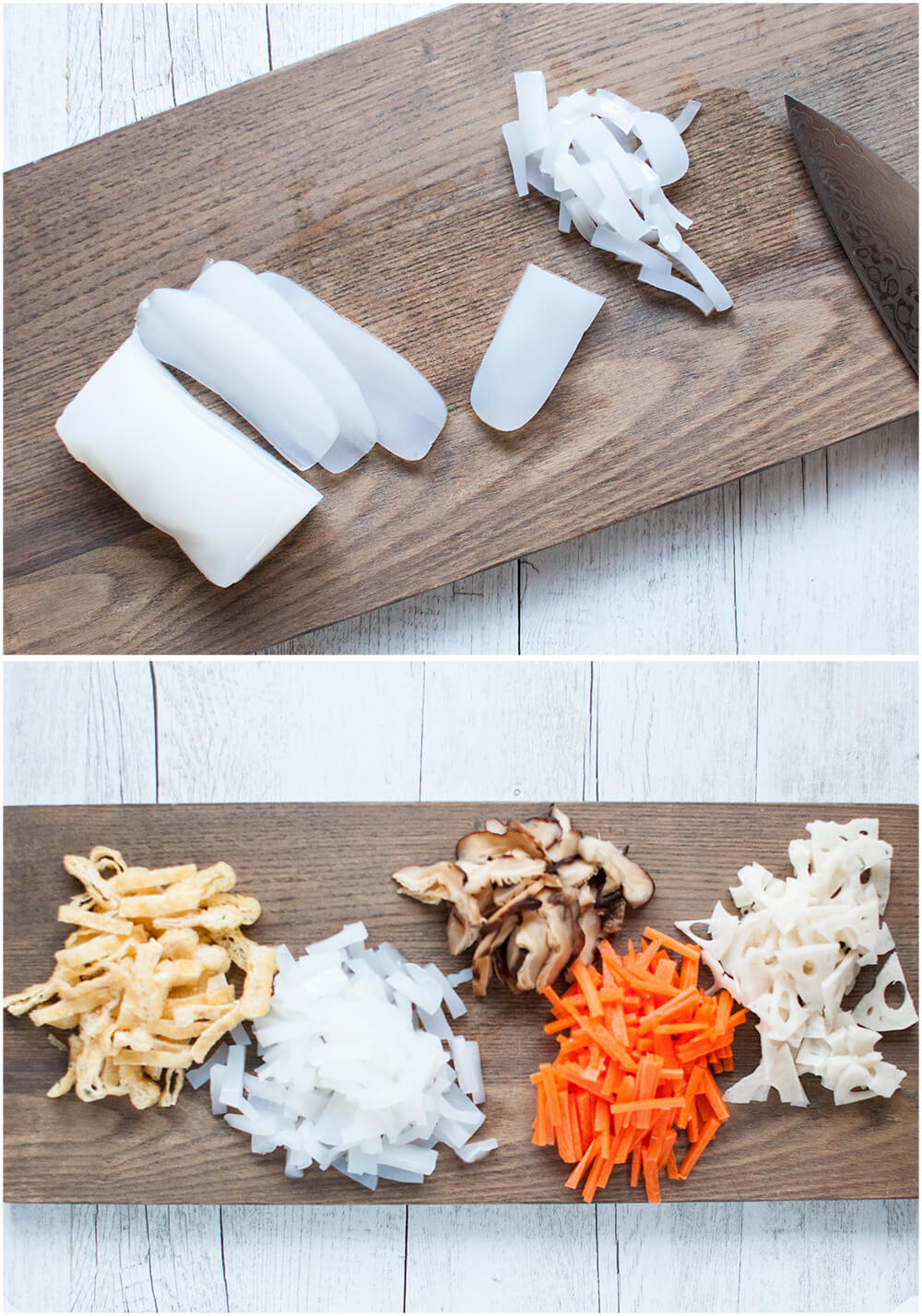
Thank you for the recipe! Looks really good with authentic Japanese flavoring plus I love the fact that this is made with 3 parts Mochi rice to 1 part regular Japanese rice! Mochi rice is nice and chewy so I really enjoy that texture!
Can you please tell me what changes I would need to make if I cooked this in a clay Kamadosan rice vessel cooked on the stove? I really enjoy the flavor and texture of Japanese rice cooked this way and feel your recipe would be amazing cooked in a Kamadosan clay rice pot.
Thank you!
Hi Telesa, you can refer to my recipe How to Cook Rice Japanese Way up to the point where you turn on the heat over medium heat and bring it to a boil. As soon as it starts boiling, reduce heat to low and cook for 15 minutes. Check to see if there is no excess water, e.g. still bubbling. If watery, keep cooking for 1-2 minutes. Then turn the heat up to medium for 10 seconds before turning off the heat. Remove from the heat and leave it for 10 minutes. Good luck with Kamadosan.
It would be nice to have measurements using American terms. I want to try this recipe…it looks very good.
Hi Betty, I tried to add American measurement but obviously I sometimes forget. Sorry about that. I will review the recipes and update them but in the mean time, if you have a particular recipe which needs American measurements, please let me know. I will fix it as top priority.
Love rice, am having black and pink rice would be interesting to see how woul they blend in with your version with few . Am enjoying different ways of cooking, Thank you.
I’ve never tried pink rice. I must try one day.
Thank you for sharing this recipe, it looks delicious! I always wanted to know how to make gomoku gohan. I love how well you explain everything, I will try it as soon as I can gather all the ingredients.
Hi Keiko, you are welcome. It is tasty and I hope you like it.